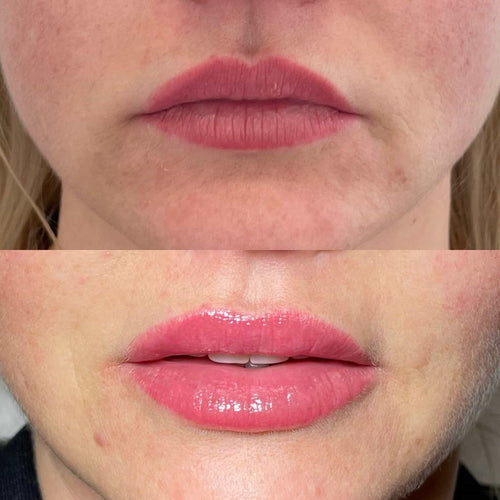Get Started with Dermal Fillers – Consult Dr. Laura Geige
Types of Fillers
Hyaluronic Acid
Tear trough treatment aims to address the undereye hollows and dark circles that can make you look tired or aged.
Hyaluronic acid (HA) fillers are a popular choice for tear trough rejuvenation because they effectively plump up the area, restoring volume and smoothing out the hollow.
Here’s a breakdown of different types of HA fillers commonly used for tear troughs:
1. **Cross-linked HA Fillers:**
These fillers contain hyaluronic acid molecules that are chemically cross-linked, making them more durable and longer-lasting than non-cross-linked HA.
Examples include Juvederm Voluma XC, Restylane Lyft, and Belotero Balance.
2. **Non-Cross-linked HA Fillers:**
These fillers are composed of smaller, less densely packed hyaluronic acid molecules, providing a softer, more natural-looking result.
They tend to last shorter than cross-linked fillers but are suitable for delicate areas like the tear trough.
Examples include Juvederm Volbella XC and Restylane Silk.
The best type of filler for your tear trough depends on various factors, including:
* **Severity of Under-Eye Hollows:**
More pronounced hollows may benefit from a more volumizing cross-linked filler.
* **Desired Results:**
A subtle, natural enhancement may be better suited to non-cross-linked fillers.
* **Skin Elasticity and Thickness
Your injector will assess your individual needs and recommend the most appropriate HA filler for your tear trough treatment.
Calcium Hydroxylapatite
Tear trough treatment involves filling in the hollow area under the eyes, often referred to as tear troughs, to create a smoother and more youthful appearance.
Various types of fillers are used for this purpose, each with its own unique properties and characteristics.
Calcium hydroxylapatite (CaHA) is a biocompatible and biodegradable filler that has gained popularity for tear trough treatment.
Here’s a detailed look at CaHA and how it compares to other common fillers:
**Calcium Hydroxylapatite (CaHA):**
CaHA is a naturally occurring mineral found in bones and teeth, making it biocompatible and well-tolerated by the body.
It works by stimulating collagen production, which helps to improve skin texture and volume. This gradual increase in collagen over time leads to long-lasting results.
**Advantages of CaHA for Tear Trough Treatment:**
– **Safety and Biocompatibility:** As a naturally occurring mineral, CaHA is highly biocompatible and has a low risk of adverse reactions.
– **Long-Lasting Results:** CaHA stimulates collagen production, resulting in longer-lasting results compared to some other fillers.
– **Natural Appearance:** CaHA provides subtle volume enhancement, creating a natural and refreshed look.
– **Corrects Undereye Hollows:** It effectively addresses the under eye hollows by lifting the skin and filling out the area.
– **Reduced Risk of Tyndall Effect:** The particle size of CaHA is larger than hyaluronic acid (HA) fillers, which can contribute to a less visible “bluish hue” known as the Tyndall effect.
**Other Fillers Used for Tear Troughs:**
Apart from CaHA, other popular filler types include:
– **Hyaluronic Acid (HA):** HA fillers are widely used and offer immediate results. They attract water to the skin, plumping up the area. However, they tend to last shorter than CaHA.
– **Poly-L-Lactic Acid (PLLA):** PLLA is a synthetic filler that stimulates collagen production over time, providing long-lasting volume enhancement.
Procedure and Considerations
Placement and Technique
Tear trough fillers are a popular choice for addressing under-eye hollows, wrinkles, and shadows. The type of filler used depends on several factors, including the severity of the concerns, patient skin type, and desired outcome.
Hyaluronic acid (HA) fillers are commonly used for tear troughs due to their ability to effectively plump up the under-eye area while being biodegradable and reversible. They come in various viscosities, allowing practitioners to choose the right consistency for optimal results.
Calcium hydroxylapatite (CaHa) fillers offer a more structured support compared to HA fillers and can be suitable for patients with deeper depressions or those seeking longer-lasting effects. However, CaHa fillers are not as easily reversible as HA.
Placement and technique are crucial for achieving natural-looking tear trough enhancement. Injecting too much filler can lead to an unnatural “overfilled” appearance, while injecting too little may not provide sufficient improvement.

The ideal injection approach involves a delicate placement along the orbital bone using small cannulas or needles, gradually adding filler in layers and smoothing it out for a seamless transition with the surrounding skin.
Experienced practitioners often use a “tear drop” technique, starting at the inner corner of the eye and extending outwards, creating a subtle lift and volumization that mimics the natural contour.
Careful consideration should be given to patient anatomy, including eyelid thickness, muscle structure, and facial symmetry.
It’s essential to select a qualified injector with extensive experience in tear trough treatments to minimize risks and achieve optimal results.
Recovery and Results
Tear trough fillers are commonly used to address dark circles and hollowness under the eyes. The choice of filler depends on several factors, including individual skin type, desired outcome, and patient preferences.
**Procedure:**
Get Your Dermal Filler Consultation with Dr. Laura Geige
- **Consultation:** A thorough consultation with a qualified injector is crucial to determine the appropriate filler and treatment plan.
- **Numbing Cream:** Topical anesthetic cream may be applied to minimize discomfort.
- **Injection:** The filler is injected precisely into the tear trough area using fine needles or cannulas.
**Considerations:**
* **Filler Type:**
* Hyaluronic acid (HA) fillers are most commonly used for tear troughs due to their versatility, biocompatibility, and ability to attract water, plumping the area. Examples include Restylane, Juvederm, and Belotero.
* Calcium hydroxyapatite (CaHa) fillers offer a more structural support option for deeper hollows.
* **Skin Type:**
* Fine, thin skin may require a softer filler to avoid visible lumps or bumps.
* Thicker skin can tolerate more volumizing fillers.
* **Desired Outcome:**
* Subtle enhancement: A small amount of filler is injected for a natural-looking lift and reduction in shadowing.
* More dramatic improvement: Larger volumes may be used to fill deeper hollows and create a more sculpted appearance.
* **Patient Health:** Individuals with certain medical conditions or allergies should consult with their doctor before undergoing any fillers.
**Recovery:**
- Downtime is minimal.
- Slight redness, swelling, and bruising are common but typically subside within a few days to a week.
- Avoid strenuous activities or facial massage for 24-48 hours post-procedure.
- Cold compresses can help reduce any swelling.
**Results:**
- Immediate improvement in the appearance of tear troughs.
- The effects of HA fillers typically last 6-18 months, depending on individual metabolism and lifestyle.
- CaHa fillers can provide longer-lasting results, up to two years or more.
Alternatives to Fillers
Fat Grafting
Tear troughs are the hollow areas under the eyes that can develop as we age, often due to fat loss and thinning skin.
While dermal fillers have become a popular choice for addressing tear troughs, there are alternatives worth considering:
Fat Grafting:
This technique involves transferring fat from another area of the body (typically the abdomen, thighs or buttocks) to the tear trough. It offers a natural-looking result as it utilizes your own tissue.
Pros:
- Natural and long-lasting results
- Less risk of allergic reactions
- Can also address volume loss in other areas during the same procedure
Cons:
- Surgical procedure requiring anesthesia and recovery time
- Potential for fat absorption or irregularities in distribution
- May require multiple sessions for optimal results
Other Alternatives:**
- Radiofrequency Microneedling: This minimally invasive procedure uses tiny needles that deliver radiofrequency energy to stimulate collagen production and tighten the skin.
- Ultherapy: A non-surgical ultrasound treatment that targets deeper layers of the skin, lifting and tightening tissues for a more youthful appearance.
- Laser Skin Resurfacing: Using lasers to remove damaged skin cells and stimulate collagen growth, this option can improve the texture and smoothness of the tear trough area.
The best alternative to fillers for tear troughs depends on individual factors such as skin type, severity of wrinkles, desired outcome, and personal preferences. Consultation with a qualified cosmetic surgeon or dermatologist is essential to determine the most appropriate treatment plan.
Dermal Fillers from Platelet-Rich Plasma (PRP)
Tear troughs, the hollows beneath the eyes, are a common area of concern for individuals seeking facial rejuvenation.
While traditional dermal fillers like hyaluronic acid are commonly used to address tear trough concerns, Platelet-Rich Plasma (PRP) offers an alternative approach utilizing the body’s own healing properties.
Here’s a detailed look at PRP as a filler option for tear troughs:
**What is PRP?**
PRP is derived from the patient’s own blood. A small amount of blood is drawn, then processed in a centrifuge to separate out the platelet-rich plasma, which contains growth factors that stimulate collagen production and tissue regeneration.
**How Does PRP Work for Tear Troughs?**
Injected into the tear trough area, PRP aims to:
- Improve skin texture and elasticity by stimulating collagen synthesis.
- Reduce the appearance of hollowness by promoting tissue volumization.
- Enhance blood circulation in the delicate under-eye area.
**Advantages of PRP for Tear Troughs:**
- Natural and Biocompatible: Utilizing your own blood minimizes the risk of allergic reactions or rejection.
- Stimulates Long-Term Improvement: The growth factors in PRP encourage ongoing collagen production, potentially leading to more lasting results than some temporary fillers.
- Minimal Downtime: Treatment sessions are typically quick and with minimal discomfort.
**Potential Drawbacks:**
- Multiple Treatments May Be Required: Unlike hyaluronic acid fillers that provide immediate results, PRP’s effects are gradual and may require several sessions spaced weeks apart.
- Results May Not Be as Dramatic: PRP is primarily focused on volumizing and improving skin quality, so it may not be suitable for those seeking significant volume augmentation.
- Potential for Bruising or Swelling: As with any injection procedure, there’s a possibility of temporary bruising or swelling around the injection sites.
Book a Consultation for Dermal Fillers with Dr. Laura Geige Today
**Conclusion:**
PRP offers a natural and potentially long-lasting alternative to traditional dermal fillers for addressing tear trough concerns. While it may require multiple treatments and may not provide the same dramatic volume as hyaluronic acid, it’s a viable option for individuals seeking a subtle and gradual rejuvenation of the under-eye area.
It’s crucial to consult with a qualified and experienced medical professional to determine if PRP is the right choice for your individual needs and goals.
Cleveland Relationship Therapy Pets R4U Reimagining Journalism Super Sleep Yoga Tableau Consulting LLC
- Lip Flip Treatment Near Epsom, Surrey - May 23, 2025
- What Kind Of Filler Is Used For Tear Trough - May 23, 2025
- What Are THC Drinks And How Do They Work? - May 22, 2025
